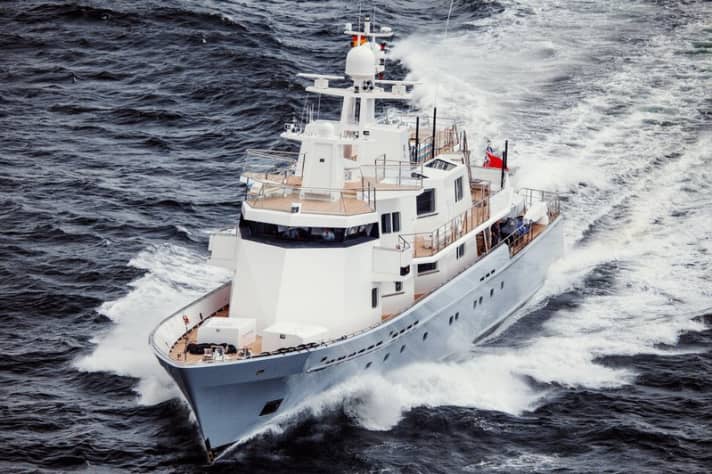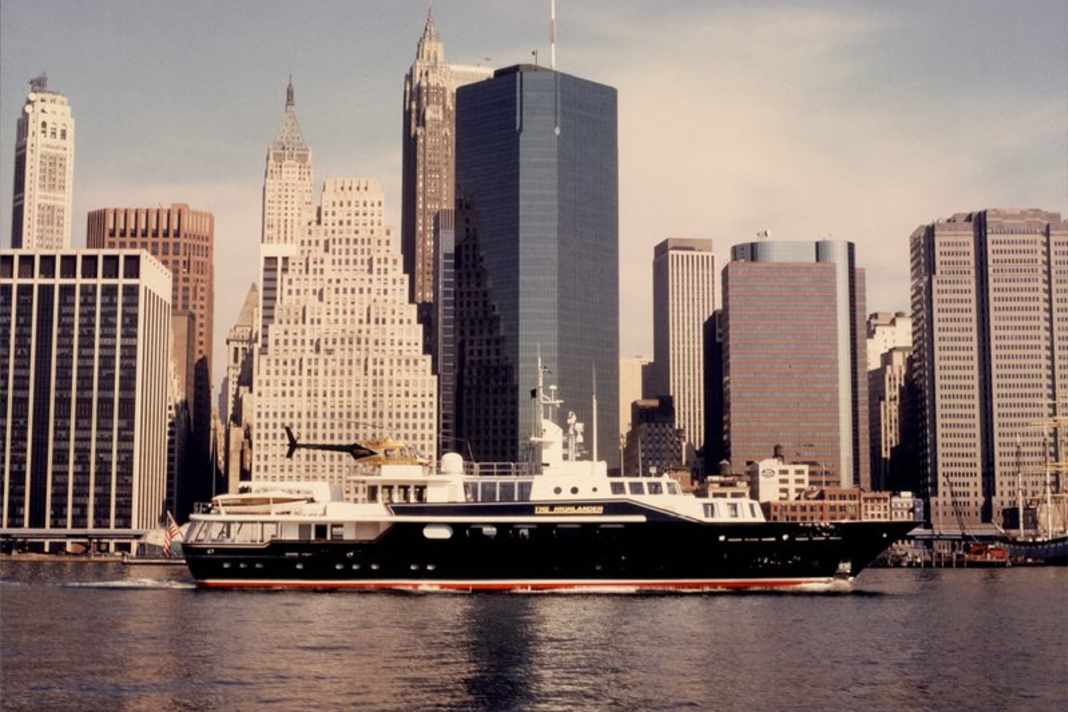





She made the start: 99 metres long, immaculate and elegant. Christina" was christened in 1954 in the still dreary post-war Kiel. The tanker king Aristotle Onassis had converted a decommissioned Canadian frigate, which he bought for scrap, into the first superyacht of the post-war era. Regardless of the cost, Howaldtswerke got the job - just five years after the reconstruction of the shipyard, which had been destroyed by bombs, began.
Named after her godmother, his three-year-old daughter, "Christina" was to be the ultimate yacht for decades, unrivalled in size and furnishings, present in the headlines, the epitome of extravagance, glamour and the elite lifestyle of the international jet set. Paparazzi shots of prominent guests on board went through the yellow press: Winston Churchill, Greta Garbo, Elizabeth Taylor with Richard Burton, Grace Kelly and Rainier, and of course "Ari's" mistress Maria Callas and his wife Jackie Kennedy. They all emphasised the status of the shipping giant.
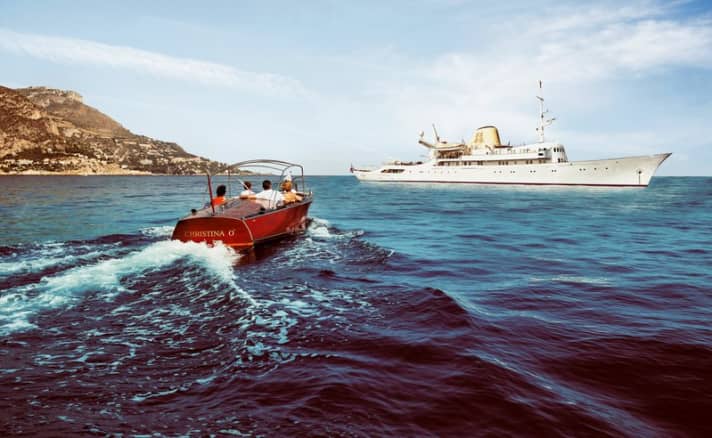
Onassis proved his taste, the harmonious exterior in the New Look of the fifties and the interior were the responsibility of the stylish Hamburg villa architect Caesar Pinnau. The mosaic in the pool, which was raised to form a dance floor, was spectacular. Onassis had a more decadent romp below deck: He had hand rails and coat hooks carved from the teeth of orcas, and at the famous bar made from the wood of a sunken Spanish galleon, people sat on stools covered in the skin of whale penises - something the landlord was said to have been keen to point out.
We have "Christina" to thank for all the banal clichés that yachting still lives with today. Onassis wrote the script. His shipowner rival Stavros Niarchos could not stand this unique position and built the 116 metre long "Atlantis" at his Hellenic shipyard in 1973, also hiring Caesar Pinnau. But Niarchos never mastered the performance of "Ari", and for years his yacht, like her successor "Atlantis II", lay immobile in Monaco's Port Hercule.
Superyachts as a status symbol is a never-ending story
It would be a while before a German shipyard would build something on the scale of "Christina". Lürssen delivered the 55 metre long "Pegasus II" in 1962, Abeking & Rasmussen 33 metres for Henry Ford a year later and the 36 metre "The A and Eagle" for the US beer dynasty Anheuser Busch in 1966. As early as 1971, the department stores' king Helmut Horten received his legendary "Carinthia VI" from Lürssen, at 71 metres in length the largest project of the young Jon Bannenberg at the time - the designer who was to revolutionise yacht design so lastingly. She was pure avant-garde, and today she is considered an icon of new yacht building. A year later, Abeking & Rasmussen received an order from a no less demanding yachtie: "Kalamoun", 46 knots with diesel for the Aga Khan. The 36.50 m speedboat was designed in aluminium by Gerhard Gilgenast from Bremen, who was to go down in yachting history as a naval architect and designer, but never achieved the nimbus of Bannenberg.
In 1983, when this type of ship was far from being on the agenda, Gilgenast designed the 30-metre F100 trawler for Fiat boss Agnelli. Agnelli, an industrialist protected around the clock, wanted to be absolutely inconspicuous with a "fish trawler". In 1988, Gilgenast designed the "T.M. Blue One" for the fashion designer Valentino, which was built by Picchiotti. It was a moderate design, but with a range of 7,000 nautical miles. His early pioneering 50-metre explorer design "Margaux Rose" was built by Schweers on the Lower Weser, famous for the gas balloon that took off from its foredeck. And in 1988, Gilgenast provided the exterior of the legendary aluminium construction "Octopussy", which was built by Heesen and was the fastest yacht of the time at 43.62 metres in length and 50 knots. Gilgenast was also involved in "Shergar", the Aga Khan's subsequent yacht, which was realised in 1983 - this time by Lürssen - as naval architect with Pininfarina as designer.
Germany became the top address for one-offs
Owners who wanted a solitaire with quality were in the right place at German shipyards. There was no talk of a "yacht industry", as there already was in Italy and Holland - the construction of superyachts was integrated into the other activities of the shipyards, with many valuable synergies. It was not until the end of the 1980s that the German shipyards decided to proactively pursue this segment. Lürssen founded its yacht division with Jörg Beiderbeck at the helm, Abeking & Rasmussen followed suit, and even the colossus Blohm & Voss no longer wanted to wait for the owners to come knocking, but to roll up the market with a yacht division. After all, the Hamburg-based company's portfolio was extremely impressive: in 1987, the shipyard made its megayacht debut with the 65-metre "Katalina".
1990 was "Lady Moura" delivered, 105 metres long, a voluminous exceptional yacht with a spectacular interior by Italian master Luigi Sturchio, plus helipad, cinema, infirmary, indoor pool and, for the first time, large retractable hatches in the hull. 1990 was also "Golden Odyssey" The 80 metre long flagship of Saudi Prince Khaled's "Golden Fleet", on which an aquarium had to be installed under the pool, was completed. A year later came the sensational counterpart, "Eco" by Martin Francis, 74.50 metres long, breathtakingly slender, with extremely curved window formations. They became her famous trademark and proof of the outstanding - if not always lucrative - capacities of a German shipyard. With her gas turbine diesel jet propulsion, "Eco" ran at 36 knots.
Feadships from the Netherlands start a success story
In Holland, the issue was approached in a completely different way to Germany after the end of the war: The "First Export Association of Dutch Shipbuilders", or Feadship for short, was founded as early as 1949, primarily to supply the lucrative American market with yachts. To this day, the group stands for an unparalleled success story. Among the founding members were the long-established family shipyards De Vries and Van Lent, as well as the designer Frits de Voogt, who shaped the face of Feadship for decades.
Like the early Feadships, all motor yachts of the 1950s and 1960s were very much in the tradition of commercial shipping or the navy. The yacht owner naturally received more pleasingly modelled lines, high-quality materials, nice upholstery and discreetly integrated bars. These were sober, efficient designs - what a stark contrast to the elegant, almost playful steam yacht whose unique design language dominated the decades before. Now they were built robustly without flair, without exception with all-round decks, a raised bow section and classic portholes; window sections served their purpose, nothing more. It was the yacht building of the time: hull, exterior and interior were developed by the shipyard, all from a single source.
Feadship yachts became a brand with the work of Frits de Voogt. "Diana II" for Germany's richest industrialist Friedrich Karl Flick was one such yacht, 60 metres long and christened in 1979, as was the 46-metre "Panimusch" from 1982 for Joachim Fürst zu Fürstenberg. The two shipyards built 160 yachts up to the millennium, and a number of 1960s yachts are still sailing today, are cool and are members of the "Feadship Heritage Fleet". In 1978, the 64.64-metre "Al Riyadh" broke the 60-metre barrier. The first Feadship with a globally functioning Satcom communication system was the 48 metre long "Daria" in 1979, and no other innovation was to change yachting more permanently. From now on, the boss was always reachable.
Further yacht builders such as Amels, Heesen, Hakvoort and Oceanco, as well as a wealth of highly specialised suppliers of increasingly complex yacht technology, made Holland the Mecca of custom building in the following decades.
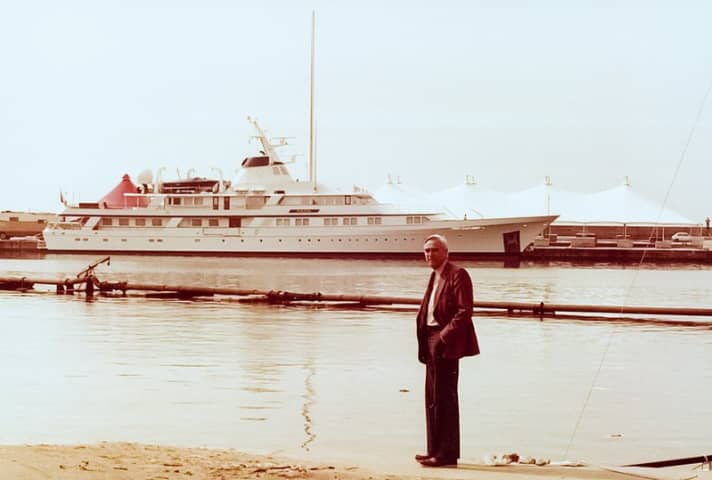
Numerous shipyards in Italy also focussed on motor yachts at an early stage, many of them such as Picchiotti, Baglietto, Codecasa and Fratelli Benetti can look back on a history rich in tradition. Various new companies were founded over the course of time, and no other country has driven the motor yacht segment forward so dynamically, of course - how could it be otherwise - with design and speed as its trademark. The specialists from the boot delivered large formats primarily to clients in the Middle East. Picchiotti built the 103-metre "Al Said" for the Sultan of Oman in 1982, and Nicolini delivered the 63-metre "Al Menwar" for Qatar in 1987, although this resulted in the collapse of the shipyard. CRN built "Shaf", 53 metres, in 1981 and "Il Vagabondo", 61 metres, in 1987, both for Saudi owners. But the electronics industrialist Max Grundig from Fürth also placed orders in Italy; his massive 62-metre-long "Maria Alexandra" was launched by Codecasa in 1981, three years before Grundig sold his company to Philips.
Kashoggi never paid the bill for "Nabila"
The christening of "Nabila" by Saudi arms dealer Adnan Kashoggi at Fratelli Benetti in 1980 was spectacular: 86 metres of Bannenberg design, five decks, discotheque, cinema, helipad, Rolls-Royce Phantom garage. The group "Queen" immortalised the yacht in their album "The Miracle", and in the James Bond thriller "Never Say Never" it is the yacht of the villain Largo. Kashoggi was forced to sell his floating palace to the Sultan of Brunei, he did not pay the construction costs - speaking of villains - and the shipyard went bankrupt on the gigantic project. The third owner, Donald Trump, named the yacht the "Trump Princess" to great media effect - there was no better way to show off wealth and prestige. "The Donald" is said to have been particularly impressed by Luigi Sturchio's, as always, breathtaking interior.
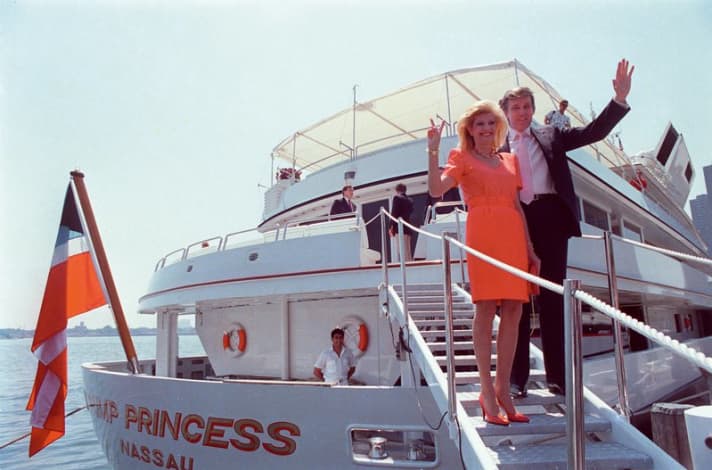
Away from the boulevard is the wealthy Saudi investor Prince al-Walid, who took over the yacht from Trump and renamed it "Kingdom 5KR". The trademark of "Nabila" is Bannenberg's winged chimneys that protrude upwards at the sides and guide the exhaust air from the ship - one of his innovations that astounded the yachting world. Bannenberg questioned everything conventional, he broke with the usual hull-deck superstructure pattern. On the sisters "Paraiso" and "Azteca", which Feadship built in 1983 for the Mexican magnate Azcárraga, he extended the side of the boat up to the second deck, placing expressive oval windows and angular glazed observation rooms on the upper deck - lines never seen before. This principle also convinced the self-confessed capitalist and big spender Malcolm Forbes, and Bannenberg designed his fifth "Highlander" for the publisher. Feadship delivered it in 1986, the fourth in total that the Dutch company had built for the motorbike fan since 1957 - the Harley was of course on board. A style story spanning three decades in its own right.
16 extremely expressive superyachts were created in Bannenberg's home country at the Australian shipyard Oceanfast. In 1985, he gave the plastic semi-displacement "Never Say Never" three deck-high portholes as windows, another feature never seen before. He also demonstrated his innovative, refined and often radical approach to interior and exterior design in 1991 with the 55-metre "Bolkiah" oceanfast for the Sultan of Brunei, who, however, parted with her. The founder of the Baden-based company FlowTex, Manfred Schmider, seized the opportunity and christened her "Maalana".
With bogus bookings, Schmider then brought Germany the country's biggest economic scandal to date and swapped Bannenberg's ingenious deck layout for jail, one of many stories that made the yacht hype before the turn of the millennium so colourful. Oceanfast was definitely a player, not least thanks to Bannenberg, but Europe dominated - and still dominates - the construction of large motor yachts. A number of shipyards in the USA - Christensen, Trinity, Broward, Burger and Delta - built in large numbers, primarily for the American market. Palmer Johnson in Sturgeon Bay, Wisconsin, was the exception for international individualists. In 1979, the traditional shipyard ventured to build the "Fortuna" for the Spanish King Juan Carlos in aluminium - 30.50 metres long and the fastest yacht in the world for a decade at 46 knots. A series of large motor yachts followed.
Customers were Malcolm Forbes, Robert Maxwell, Larry Ellison
The era of yacht design as a discipline in its own right began with Jon Bannenberg. A proud line-up of talents emerged from his London office - Andrew Winch, Terence Disdale, Donald Starkey, Tim Heywood, a purely British domain. They were all to dominate the scene in the years that followed. From now on, shipyards executed what designers created - no matter what, often at extreme expense. The haggling between designers and shipyards over what was feasible was legendary. The more complex the task, the more difficult it was to calculate the construction costs. Yachts at a fixed price only became possible again when shipyards started to offer semi-customs, where the options for the owner were manageable.
The rapid development was not only accompanied by increasing length - a simple, not entirely incorrect formula stated that yachts grew by ten metres every ten years - but above all by technical innovation. Consumption, insulation, communication, air conditioning, water treatment, stabilisation - the list of requirements exploded. Design tasks were mastered with the help of various CAD programmes: Openings in the hull, retractable floating platforms, helipads, garages for veritable tender fleets, wellness landscapes, floor-to-ceiling movable glass fronts, open foyers, lightweight interiors, lifts that ran through several decks even when tilted. Space was fought for centimetre by centimetre, energy was calculated and the hopefully professional crew was briefed for all functions. Crewing itself became an issue, and yachts often only grew because people realised that a good crew also needed attractive accommodation.
Followers tried to participate in the boom with shipyards that were built from scratch and then closed down again. However, the yacht building industry that emerged in the last decades of the millennium was characterised by extreme professionalism and expertise, by courageous entrepreneurial spirit, by shipyards that met the often exorbitant demands of wealthy owners. In short: an unrivalled industry.
Finally, let's stay in Germany: Lürssen built the exciting "Izanami" in 1993 - 59 grey, angular metres by star architect Norman Foster on a speedboat hull. The elegant and harmonious 97-metre Bannenberg design "Limitless" from 1997, on the other hand, is a completely different story. And with the largest yacht ever built to date, the 139 metre long "Al Salamah" for Saudi Arabia, the shipyard heralded the next millennium. But is such a gigantic six-decker with 8,000 square metres of living space still a yacht? A legitimate question at the time - today we answer it with a resounding yes. "Al Salamah" has currently dropped to 18th place in the rankings. In the new millennium, we should experience completely different dimensions.
